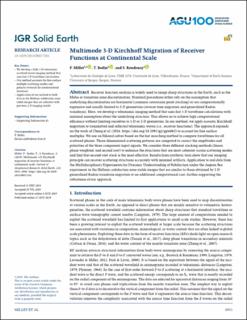| dc.contributor.author | Millet, Florian | |
| dc.contributor.author | Bodin, Thomas | |
| dc.contributor.author | Rondenay, Stéphane | |
| dc.date.accessioned | 2021-02-09T14:25:36Z | |
| dc.date.available | 2021-02-09T14:25:36Z | |
| dc.date.created | 2020-01-16T12:56:56Z | |
| dc.date.issued | 2019 | |
| dc.Published | Journal of Geophysical Research: Solid Earth. 2019, 124 (8), 8953-8980. | en_US |
| dc.identifier.issn | 2169-9313 | |
| dc.identifier.uri | https://hdl.handle.net/11250/2726971 | |
| dc.description.abstract | Receiver function analysis is widely used to image sharp structures in the Earth, such as the Moho or transition zone discontinuities. Standard procedures either rely on the assumption that underlying discontinuities are horizontal (common conversion point stacking) or are computationally expensive and usually limited to 2‐D geometries (reverse time migration and generalized Radon transform). Here, we develop a teleseismic imaging method that uses fast 3‐D traveltime calculations with minimal assumption about the underlying structure. This allows us to achieve high computational efficiency without limiting ourselves to 1‐D or 2‐D geometries. In our method, we apply acoustic Kirchhoff migration to transmitted and reflected teleseismic waves (i.e., receiver functions). The approach expands on the work of Cheng et al. (2016, https://doi.org/10.1093/gji/ggw062) to account for free surface multiples. We use an Eikonal solver based on the fast marching method to compute traveltimes for all scattered phases. Three‐dimensional scattering patterns are computed to correct the amplitudes and polarities of the three component input signals. We consider three different stacking methods (linear, phase weighted, and second root) to enhance the structures that are most coherent across scattering modes and find that second‐root stack is the most effective. Results from synthetic tests show that our imaging principle can recover scattering structures accurately with minimal artifacts. Application to real data from the Multidisciplinary Experiments for Dynamic Understanding of Subduction under the Aegean Sea experiment in the Hellenic subduction zone yields images that are similar to those obtained by 2‐D generalized Radon transform migration at no additional computational cost, further supporting the robustness of our approach. | en_US |
| dc.language.iso | eng | en_US |
| dc.publisher | Wiley | en_US |
| dc.rights | Navngivelse 4.0 Internasjonal | * |
| dc.rights.uri | http://creativecommons.org/licenses/by/4.0/deed.no | * |
| dc.title | Multimode 3‐D Kirchhoff Migration of Receiver Functions at Continental Scale | en_US |
| dc.type | Journal article | en_US |
| dc.type | Peer reviewed | en_US |
| dc.description.version | publishedVersion | en_US |
| dc.rights.holder | Copyright 2019. The Authors. | en_US |
| cristin.ispublished | true | |
| cristin.fulltext | original | |
| cristin.qualitycode | 2 | |
| dc.identifier.doi | 10.1029/2018JB017288 | |
| dc.identifier.cristin | 1774780 | |
| dc.source.journal | Journal of Geophysical Research (JGR): Solid Earth | en_US |
| dc.source.40 | 124 | en_US |
| dc.source.14 | 8 | en_US |
| dc.source.pagenumber | 8953-8980 | en_US |
| dc.relation.project | Norges forskningsråd: 231354 | en_US |

